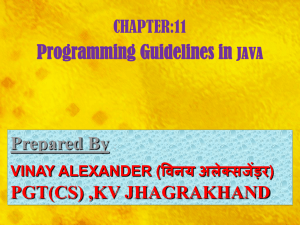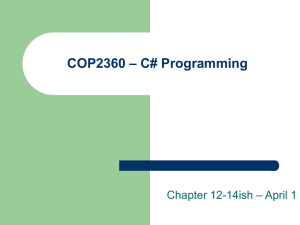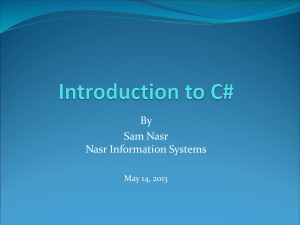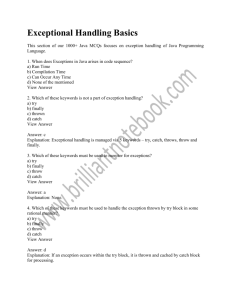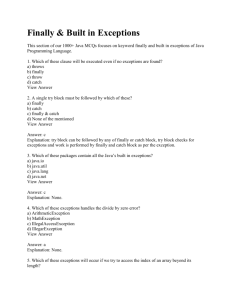PART 15
advertisement
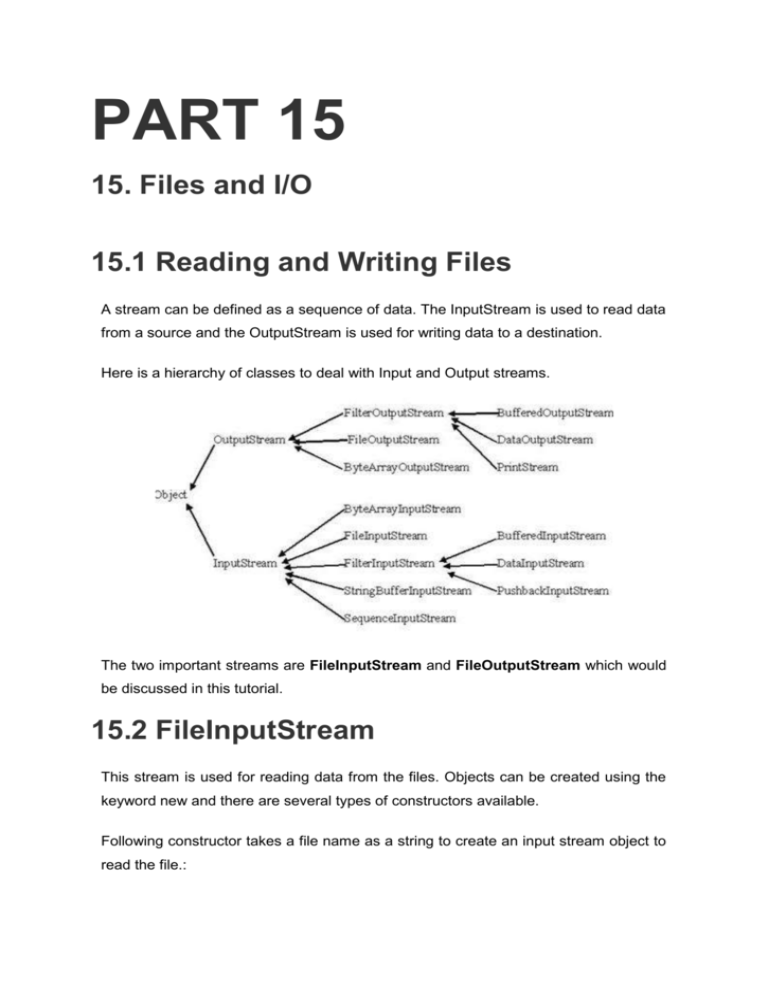
PART 15
15. Files and I/O
15.1 Reading and Writing Files
A stream can be defined as a sequence of data. The InputStream is used to read data
from a source and the OutputStream is used for writing data to a destination.
Here is a hierarchy of classes to deal with Input and Output streams.
The two important streams are FileInputStream and FileOutputStream which would
be discussed in this tutorial.
15.2 FileInputStream
This stream is used for reading data from the files. Objects can be created using the
keyword new and there are several types of constructors available.
Following constructor takes a file name as a string to create an input stream object to
read the file.:
InputStream f = new FileInputStream("C:/java/hello");
Following constructor takes a file object to create an input stream object to read the
file. First we create a file object using File() method as follows:
File f = new File("C:/java/hello");
InputStream f = new FileInputStream(f);
Once you have InputStream object in hand then there is a list of helper methods which
can be used to read to stream or to do other operations on the stream.
Methods with Description
public void close() throws IOException{}
This method closes the file output stream. Releases any system resources associated with the file.
Throws an IOException.
public int read(byte[] r) throws IOException{}
This method reads r.length bytes from the input stream into an array. Returns the total number of
bytes read. If end of file -1 will be returned.
public int available() throws IOException{}
Gives the number of bytes that can be read from this file input stream. Returns an int.
15.3 FileOutputStream
FileOutputStream is used to create a file and write data into it.The stream would
create a file, if it doesn't already exist, before opening it for output.
Here are two constructors which can be used to create a FileOutputStream object.
Following constructor takes a file name as a string to create an input stream object to
write the file.:
OutputStream f = new FileOutputStream("C:/java/hello")
Following constructor takes a file object to create an output stream object to write the
file. First we create a file object using File() method as follows:
File f = new File("C:/java/hello");
OutputStream f = new FileOutputStream(f);
Once you have OutputStream object in hand then there is a list of helper methods
which can be used to write to stream or to do other operations on the stream.
Methods with Description
public void close() throws IOException{}
This method closes the file output stream. Releases any system resources associated with the file.
Throws an IOException.
public void write() throws IOException{}
This methods writes the specified byte to the output stream.
Example
Following is the example to demonstrate InputStream and OutputStream:
import java.io.*;
public class fileStreamTest{
public static void main(String args[]){
try{
char[] data = {‘a’,’b’,’c’,’d’,’e’};
OutputStream outfile = new FileOutputStream("C:/test.txt");
for(int x=0; x < data.length ; x++){
outfile.write( data[x] ); // writes the bytes
}
outfile.close();
InputStream infile = new FileInputStream("C:/test.txt");
int size = infile.available();
for(int i=0; i< size; i++){
System.out.print((char) infile.read() + "
}
infile.close();
");
}catch(IOException e){
System.out.print("Exception");
}
}
}
The above code would create file test.txt and would write given characters. Same
would be output on the stdout screen.
15.4 File Navigation and I/O
There are several other classes that we would be going through to get to know the
basics of File Navigation and I/O.
FileReader Class
FileWriter Class
File Class
File Reader
This class inherits from the InputStream class. FileReader is used for reading streams
of characters.
Following syntax creates a new FileReader, given the File to read from.
FileReader(File file)
File Writer
This class inherits from the OutputStream class. The class is used for writing streams
of characters.
Following syntax creates a FileWriter object given a File object.
FileWriter(File file)
Example
Following is the example to demonstrate class:
import java.io.*;
public class FileRead{
public static void main(String args[])throws IOException{
File file = new File("Hello1.txt");
// creates the file
file.createNewFile();
// creates a FileWriter Object
FileWriter writer = new FileWriter(file);
// Writes the content to the file
writer.write("This\n is\n an\n example\n");
writer.flush();
writer.close();
//Creates a FileReader Object
FileReader fr = new FileReader(file);
//Creates a LineNumberReader Object
LineNumberReader lnreader = new LineNumberReader(fr);
String line = "";
while ((line = lnreader.readLine()) != null) {
System.out.println(lnreader.getLineNumber() + ": " + line);
}
fr.close();
}
}
This would produce following result:
1: This
2: is
3: an
4: example
15.4 Directories in Java
Creating Directories
There are two useful File utility methods which can be used to create directories:
The mkdir( ) method creates a directory, returning true on success and false
on failure. Failure indicates that the path specified in the File object already
exists, or that the directory cannot be created because the entire path does not
exist yet.
The mkdirs() method creates both a directory and all the parents of the
directory.
Following example creates "c:/java/example/folder" directory:
import java.io.File;
public class CreateDir {
public static void main(String args[]) {
String dirname = "c:/java/example/folder";
File d = new File(dirname);
// Create directory now.
if(d.mkdirs())
{ System.out.print(“created”); }
else
{ System.out.print(“error! Not created”); }
}
}
Note: Java automatically takes care of path separators on UNIX and Windows as per
conventions. If you use a forward slash (/) on a Windows version of Java, the path will
still resolve correctly.
Reading Directories:
A directory is a File that contains a list of other files and directories. When you create
a File object and if it is a directory, the isDirectory( ) method will return true.
You can call list( ) on that object to extract the list of other files and directories inside.
The program shown here illustrates how to use list( ) to examine the contents of a
directory:
import java.io.File;
public class DirList {
public static void main(String args[]) {
String dirname = "c:/mysql";
File f1 = new File(dirname);
if (f1.isDirectory()) {
System.out.println( "Directory of " + dirname);
String s[] = f1.list();
for (int i=0; i < s.length; i++) {
File f = new File(dirname + "/" + s[i]);
if (f.isDirectory()) {
System.out.println(s[i] + " is a directory");
} else {
System.out.println(s[i] + " is a file");
}
}
} else {
System.out.println(dirname + " is not a directory");
}
}
}
This would produce following result:
Directory of /mysql
bin is a directory
lib is a directory
demo is a directory
test.txt is a file
README is a file
index.html is a file
include is a directory
PART 16
16. Exceptions
An exception is a problem that arises during the execution of a program. An exception
can occur for many different reasons, including the following:
A user has entered invalid data.
A file that needs to be opened cannot be found.
A network connection has been lost in the middle of communications, or the
JVM has run out of memory.
Some of these exceptions are caused by user error, others by programmer error, and
others by physical resources.
To understand how exception handling works in Java, you need to understand the
three categories of exceptions:
Checked exceptions: A checked exception is an exception that is typically a
user error or a problem that cannot be foreseen by the programmer. For
example, if a file is to be opened, but the file cannot be found, an exception
occurs.
Runtime exceptions: A runtime exception is an exception that occurs that
probably could have been avoided by the programmer.
Errors: These are not exceptions at all, but problems that arise beyond the
control of the user or the programmer. For example, if a stack overflow occurs,
an error will arise. They are ignored at the time of compilation.
16.1 Exception Hierarchy
All exception classes are subtypes of the java.lang.Exception class. The exception
class is a subclass of the Throwable class. There is another subclass called Error
which is derived from the Throwable class.
Errors are not normally trapped from the Java programs. These conditions normally
happen in case of severe failures, which are not handled by the java programs. Errors
are generated to indicate errors generated by the runtime environment. Example :
JVM is out of Memory. Normally programs cannot recover from errors.
The Exception class has two main subclasses :
IOException class and
RuntimeException Class.
16.2 Java - Built-in Exceptions
The
most
general
of
exceptions
are
subclasses
of
the
standard
type
RuntimeException.
Java defines several other types of exceptions that relate to its various class libraries.
Following is the list of Java Unchecked RuntimeException.
Exception
Description
ArithmeticException
Arithmetic error, such as divide-by-zero.
ArrayIndexOutOfBoundsException
Array index is out-of-bounds.
ArrayStoreException
Assignment to an array element of an incompatible type.
ClassCastException
Invalid cast.
IllegalArgumentException
Illegal argument used to invoke a method.
IllegalMonitorStateException
Illegal monitor operation, such as waiting on an unlocked thread.
IllegalStateException
Environment or application is in incorrect state.
IllegalThreadStateException
Requested operation not compatible with current thread state.
IndexOutOfBoundsException
Some type of index is out-of-bounds.
NegativeArraySizeException
Array created with a negative size.
NullPointerException
Invalid use of a null reference.
NumberFormatException
Invalid conversion of a string to a numeric format.
SecurityException
Attempt to violate security.
StringIndexOutOfBounds
Attempt to index outside the bounds of a string.
UnsupportedOperationException
An unsupported operation was encountered.
Following is the list of Java Checked Exceptions.
Exception
Description
ClassNotFoundException
Class not found.
CloneNotSupportedException
Attempt to clone an object that does not implement the Cloneable
interface.
IllegalAccessException
Access to a class is denied.
InstantiationException
Attempt to create an object of an abstract class or interface.
InterruptedException
One thread has been interrupted by another thread.
NoSuchFieldException
A requested field does not exist.
NoSuchMethodException
A requested method does not exist.
16.3 Catching Exceptions
A method catches an exception using a combination of the try and catch keywords. A
try/catch block is placed around the code that might generate an exception. Code
within a try/catch block is referred to as protected code, and the syntax for using
try/catch looks like the following:
try
{
//Protected code
}catch(ExceptionName e1)
{
//Catch block
}
A catch statement involves declaring the type of exception you are trying to catch. If
an exception occurs in protected code, the catch block (or blocks) that follows the try
is checked. If the type of exception that occurred is listed in a catch block, the
exception is passed to the catch block much as an argument is passed into a method
parameter.
Example
The following is an array is declared with 2 elements. Then the code tries to access
the 3rd element of the array which throws an exception.
// File Name : ExcepTest.java
import java.io.*;
public class ExcepTest{
public static void main(String args[]){
try{
int a[] = new int[2];
System.out.println("Access element three :" + a[3]);
}catch(ArrayIndexOutOfBoundsException e){
System.out.println("Exception thrown :" + e);
}
}
}
This would produce following result:
Exception thrown
:java.lang.ArrayIndexOutOfBoundsException: 3
16.4 Multiple catch Blocks
A try block can be followed by multiple catch blocks. The syntax for multiple catch
blocks looks like the following:
try
{
//Protected code
}catch(ExceptionType1 e1)
{
//Catch block
}catch(ExceptionType2 e2)
{
//Catch block
}catch(ExceptionType3 e3)
{
//Catch block
}
The previous statements demonstrate three catch blocks, but you can have any
number of them after a single try. If an exception occurs in the protected code, the
exception is thrown to the first catch block in the list. If the data type of the exception
thrown matches ExceptionType1, it gets caught there. If not, the exception passes
down to the second catch statement. This continues until the exception either is
caught or falls through all catches, in which case the current method stops execution
and the exception is thrown down to the previous method on the call stack.
Example
Here is code segment showing how to use multiple try/catch statements.
try
{
file = new FileInputStream(fileName);
x = (byte) file.read();
}catch(IOException i)
{
i.printStackTrace();
return -1;
}catch(FileNotFoundException f) //Not valid!
{
f.printStackTrace();
return -1;
}
16.5 throws/throw Keywords
If a method does not handle a checked exception, the method must declare it using
the throws keyword. The throws keyword appears at the end of a method's signature.
Throws keyword sends the exception to another class.
The following method declares that it throws a RemoteException:
import java.io.*;
public class className
{
public void deposit(double amount) throws RemoteException
{
// Method implementation
throw new RemoteException();
}
//Remainder of class definition
}
A method can declare that it throws more than one exception, in which case the
exceptions are declared in a list separated by commas. For example, the following
method declares that it throws a RemoteException and an
InsufficientFundsException:
import java.io.*;
public class className
{
public void withdraw(double amount)throws RemoteException, InsufficientFundsException
{
// Method implementation
}
//Remainder of class definition
}
16.6 finally Keyword
The finally keyword is used to create a block of code that follows a try block. A finally
block of code always executes, whether or not an exception has occurred.
A finally block appears at the end of the catch blocks and has the following syntax:
try
{
//Protected code
}catch(ExceptionType1 e1)
{
//Catch block
}catch(ExceptionType2 e2)
{
//Catch block
}catch(ExceptionType3 e3)
{
//Catch block
}finally
{
//The finally block always executes.
}
Example
public class ExcepTest{
public static void main(String args[]){
int a[] = new int[2];
try{
System.out.println("Access element three :" + a[3]);
}catch(ArrayIndexOutOfBoundsException e){
System.out.println("Exception thrown :" + e);
}
finally{
a[0] = 6;
System.out.println("First element value: " +a[0]);
System.out.println("The finally statement is executed");
}
}
}
This would produce following result:
Exception thrown :java.lang.ArrayIndexOutOfBoundsException: 3
First element value: 6
The finally statement is executed
Note the following:
A catch clause cannot exist without a try statement.
It is not compulsory to have finally clauses when ever a try/catch block is
present.
The try block cannot be present without either catch clause or finally clause.
